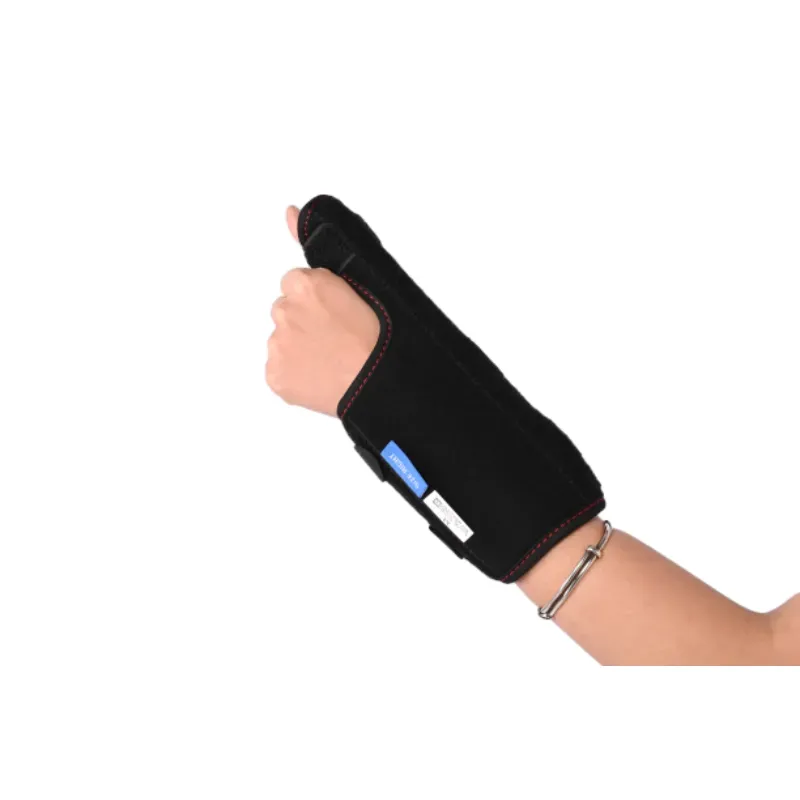Esplorazione della biomeccanica nella progettazione di tutori per il polso
La biomeccanica delle stecche da polso gioca un ruolo cruciale nella progettazione e nell'efficacia di prodotti come vendo stecca per polso, tutore per dita con supporto per polso, E stecca flessibile per il pollice. Understanding the natural movements and forces acting on the wrist is essential in creating splints that offer proper support, flexibility, and comfort. In this article, we’ll explore how biomechanical principles influence wrist splint design, highlighting their impact on function and patient recovery.

Stecca biomeccanica dietro il polso in vendita
Il design di un vendo stecca per polso incorporates key biomechanical concepts to ensure optimal support and movement restriction. Wrist splints are designed to support the wrist joint while allowing for a natural range of motion in the fingers and thumb. By applying principles like load distribution and force absorption, the splint alleviates pressure on the wrist joint, which is particularly important for conditions such as sprains, arthritis, or carpal tunnel syndrome. Understanding how forces affect the wrist allows manufacturers to create a vendo stecca per polso che fornisce il giusto equilibrio tra supporto e mobilità.
Tutore per dita con supporto per polso: meccanica funzionale
IL tutore per dita con supporto per polso is an innovative design that combines support for the fingers and the wrist in one cohesive unit. Biomechanically, this design helps prevent unwanted motion in both the wrist and finger joints while still enabling essential hand movements. This is particularly useful for those recovering from injuries like fractures or tendon strains. The incorporation of joint stabilization principles ensures that the splint provides the necessary immobilization without interfering with blood circulation or causing muscle stiffness, thus promoting a quicker recovery.
Tutore flessibile per il pollice: equilibrio tra mobilità e stabilità
IL stecca flessibile per il pollice is designed with biomechanics in mind to strike a balance between mobility and stability. Its flexible material allows the thumb to move within a controlled range while providing support to the joint, which is essential for reducing pain caused by conditions such as thumb arthritis or tendonitis. Biomechanically, a thumb splint must allow for functional motion while preventing excessive stress on the joint. The use of flexible yet supportive materials ensures that the splint offers both stability and the freedom to move, aiding the rehabilitation process.
Considerazioni biomeccaniche nella personalizzazione delle stecche da polso
Every patient’s biomechanical needs are unique, and the vendo stecca per polso, insieme ad altri tipi come il tutore per dita con supporto per polso E stecca flessibile per il pollice, should be customized for maximum effectiveness. By understanding the specific biomechanics of the individual’s wrist, hand, and fingers, manufacturers can design splints that fit comfortably and provide the most support where needed. Customization may involve adjusting the degree of immobilization, selecting the right materials for comfort, and ensuring that the splint aligns with the patient’s natural wrist movement.
Impatto della biomeccanica sul recupero con stecche per il polso
Il successo delle stecche da polso nel promuovere la guarigione si basa in gran parte sulla loro aderenza ai principi biomeccanici. vendo stecca per polso, tutore per dita con supporto per polso, E stecca flessibile per il pollice tutti lavorano aiutando a stabilizzare il polso e il pollice, riducendo lo sforzo su muscoli e legamenti. Considerando attentamente le forze biomeccaniche che agiscono sul polso, i produttori possono progettare stecche che supportano un posizionamento ottimale, riducendo così il dolore e favorendo il recupero. Il giusto design biomeccanico può non solo proteggere l'area infortunata, ma anche facilitare un processo di guarigione più rapido e confortevole.
In conclusione, la comprensione della biomeccanica è essenziale per la progettazione di tutori per il polso come il vendo stecca per polso, tutore per dita con supporto per polso, E stecca flessibile per il pollice. These splints are designed to provide the right combination of support, flexibility, and comfort, ensuring effective rehabilitation and promoting faster recovery. Whether it’s a simple sprain or a chronic condition, the correct splint can significantly improve a patient’s quality of life and help them return to their daily activities sooner.
-
Top Back Support SolutionsNotizia Jul.28,2025
-
Support for Hand and Thumb HealthNotizia Jul.28,2025
-
Powerful Back Support SolutionsNotizia Jul.28,2025
-
Essential Back Support SolutionsNotizia Jul.28,2025
-
Effective Hand and Wrist Support SolutionsNotizia Jul.28,2025
-
Comprehensive Thoracic and Lumbar SupportNotizia Jul.28,2025





















